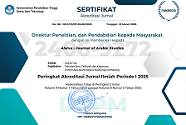Taṭwīr Adawāt al-Taqwīm al-Takwīnī al-Qā’imah ʿalā Kahoot li-Tarqīyat Itqān al-Mufradāt fī Taʿlīm al-Lughah al-ʿArabīyah bil-Madrasah al-Mihanīyah
DOI:
https://doi.org/10.21580/alsina.5.2.22933Keywords:
Arabic language education, formative assessment tools, interactive learning, Kahoot, vocabulary masteryAbstract
This study aims to develop and test the effectiveness of formative assessment tools based on Kahoot to improve students' mastery of Arabic vocabulary. This study responds to the lack of variety in traditional assessment methods, which makes students feel bored and negatively impacts their ability to understand and retain vocabulary. The study used the Research and Development (R&D) method with the ADDIE model, which includes analysis, design, development, implementation, and evaluation. The study involved a sample of students divided into experimental and control groups, and the test results were analyzed using appropriate statistical analysis. The findings showed that interactive assessment tools based on Kahoot effectively enhance students' mastery of Arabic vocabulary, with a statistically significant difference in test results between the groups, where the experimental group demonstrated a noticeable improvement in test scores.
Downloads
References
Adnyani, Kadek Eva Krishna, I Wayan Adnyana, Ni Nyoman Murniasih, and Ni Komang Arie Suwastini. “Implementing Kahoot! For Japanese Language Learning in Indonesian High School.” Journal of Education Technology 6, no. 2 (2022): 217–25. https://doi.org/10.23887/jet.v6i2.46102.
Ahmed, Alim Al Ayub, Biju Theruvil Sayed, Ismail Suardi Wekke, Mulyanto Widodo, Dian Rostikawati, Muneam Hussein Ali, Hamed Ali Abdul Hussein, and Mahdieh Azizian. “An Empirical Study on the Effects of Using Kahoot as a Game-Based Learning Tool on EFL Learners’ Vocabulary Recall and Retention.” Education Research International, 2022, 1–10. https://doi.org/https://doi.org/10.1155/2022/9739147.
Badan Standar, Kurikulum, dan Asesmen Pendidikan Kementerian Pendidikan, Kebudayaan, Riset, dan Teknologi Republik Indonesia. Revisi Capaian Pembelajaran pada Kurikulum Merdeka, Pub. L. No. 1152 (2023).
Camacho-Sánchez, Rubén, Jorge Serna Bardavío, Aaron Rillo-Albert, and Pere Lavega-Burgués. “Enhancing Motivation and Academic Performance through Gamified Digital Game-Based Learning Methodology Using the ARCS Model.” Interactive Learning Environments, 2023, 1–18. https://doi.org/10.1080/10494820.2023.2294762.
Dawson, Phillip, Michael Henderson, Tracii Ryan, Paige Mahoney, David Boud, Michael Phillips, and Elizabeth Molloy. “Technology and Feedback Design.” In Learning, Design, and Technology, 1–45. Cham: Springer International Publishing, 2018. https://doi.org/10.1007/978-3-319-17727-4_124-1.
Eaton, Sarah Elaine. Global Trends in Language Learning in the Twenty-FIrst Centur. Calgary: Onate Press, 2010.
Eltahir, Mohd. Elmagzoub, Najeh Rajeh Alsalhi, Sami Al-Qatawneh, Hatem Ahmad AlQudah, and Mazan Jaradat. “The Impact of Game-Based Learning (GBL) on Students’ Motivation, Engagement and Academic Performance on an Arabic Language Grammar Course in Higher Education.” Education and Information Technologies 26, no. 3 (2021): 3251–78. https://doi.org/10.1007/s10639-020-10396-w.
Hudri, Mawaddah. “Kahoot Application as Learning Platform for Evaluation of Arabic Vocabulary Elements.” In International Conference on Arabic Language and Literature, 4:403–10. Bandung: Universitas Pendidikan Indonesia, 2021. http://proceedings2.upi.edu/index.php/ical/article/view/1869.
Irwan, Irwan. “Implementasi Kahoot! sebagai Inovasi Pembelajaran.” Journal of Civic Education 2, no. 1 (2019): 126–40. https://doi.org/10.24036/jce.v2i1.130.
Kapsalis, Georgios D., Alexandra Galani, and Olga Tzafea. “Kahoot! As a Formative Assessment Tool in Foreign Language Learning: A Case Study in Greek as an L2.” Theory and Practice in Language Studies 10, no. 11 (2020): 1343–50. https://doi.org/10.17507/tpls.1011.01.
Kim, Ahyoung Alicia, Rurik L. Tywoniw, and Mark Chapman. “Technology-Enhanced Items in Grades 1–12 English Language Proficiency Assessments.” Language Assessment Quarterly 19, no. 4 (2022): 343–67. https://doi.org/10.1080/15434303.2022.2039659.
Kohnke, Lucas, and Benjamin Luke Moorhouse. “Using Kahoot! To Gamify Learning in the Language Classroom.” RELC Journal 53, no. 3 (2022): 769–75. https://doi.org/10.1177/00336882211040270.
Lundeto, Adri, Misbahuddin Misbahuddin, Zainuddin Soga, Hasnil Oktavera, Siti Nurhasana Mokodompit, and Najwa Hasania. “Pelatihan Desain Pembelajaran Mufaradat Bahasa Arab melalui Media Kahoot! bagi Guru-guru Bahasa Arab Kota Manado.” TARSIUS: Jurnal Pengabdian Tarbiyah, Religius, Inovatif, Edukatif dan Humanis 4, no. 2 (2022): 59–67. https://ejournal.iain-manado.ac.id/index.php/tarsius/article/view/512.
Maghfiroh, Zaidatul L., and Sufirmansyah. “Optimalisasi Evaluasi Pembelajaran Bahasa Arab Menggunakan Aplikasi Kahoot di SD NU Gurah Kediri.” Al-Makrifat 7, no. 2 (2022): 1–19. https://ejournal.kopertais4.or.id/tapalkuda/index.php/makrifat/article/view/4844.
Mayer, Richard E. “Cognitive Theory of Multimedia Learning.” In The Cambridge Handbook of Multimedia Learning, edited by Richard E. Mayer, 43–71. Cambridge: Cambridge University Press, 2014. https://doi.org/10.1017/CBO9781139547369.005.
Naifah. Evaluasi Pembelajaran Bahasa Arab. Semarang: Southeast Asian Publishing, 2021.
Rasydiana, Rasydiana, Yusuf Hanafi, and Ibnu Samsul Huda. “Pengembangan Tes Pembelajaran Bahasa Arab Menggunakan Aplikasi Kahoot Di MTsN 2 Kota Malang.” In Prosiding Konferensi Nasional Bahasa Arab V, 5:437–47. Malang: Universitas Negeri Malang, 2019. https://prosiding.arab-um.com/index.php/konasbara/article/view/513.
Rayanto, Yudi Hari, and Sugianti. Penelitian Pengembangan Model ADDIE dan R2D2: Teori dan Praktek. Pasuruan: Lembaga Academic & Research Institute, 2020.
Rojabi, Ahmad Ridho, Slamet Setiawan, Ahmad Munir, Oikurema Purwati, Rizka Safriyani, Nina Hayuningtyas, Siti Khodijah, and Rengganis Siwi Amumpuni. “Kahoot, Is It Fun or Unfun? Gamifying Vocabulary Learning to Boost Exam Scores, Engagement, and Motivation.” Frontiers in Education 7 (2022): 1–11. https://doi.org/10.3389/feduc.2022.939884.
Ruiz, Cristina González. “The Effect of Integrating Kahoot! And Peer Instruction in the Spanish Flipped Classroom: The Student Perspective.” Journal of Spanish Language Teaching 8, no. 1 (2021): 63–78. https://doi.org/10.1080/23247797.2021.1913832.
Saleem, Awaz Naaman, Narmin Mohammed Noori, and Fezile Ozdamli. “Gamification Applications in E-Learning: A Literature Review.” Technology, Knowledge and Learning 27, no. 1 (2022): 139–59. https://doi.org/10.1007/s10758-020-09487-x.
Sugiyono. Metode Penelitian Kuantitatif, Kualitatif, Dan R&D. Bandung: Alfabeta, 2017.
Suharsono, M. Ja’far Shodiq, and Yusuf Muhtarom. “Inovasi Penilaian Pembelajaran Bahasa Arab Berbasis Games KAHOOT untuk Meningkatkan Keterampilan Menyimak di Ma`had IIT Rabbani Bengkulu.” Mahira: Journal of Arabic Studies & Teaching 1, no. 2 (2023): 149–57. https://ejournal.uin-suka.ac.id/tarbiyah/mahira/article/view/5792.
Wolf, Mikyung Kim, and Alexis A. Lopez. “Developing a Technology-Based Classroom Assessment of Academic Reading Skills for English Language Learners and Teachers: Validity Evidence for Formative Use.” Languages 7, no. 2 (2022): 71. https://doi.org/10.3390/languages7020071.
Wulandari, Nawang. “Pengembangan Buku Saku Intensifikasi Bahasa Arab di IAIN METRO dengan Menggunakan Model ADDIE.” Al-Fathin: Jurnal Bahasa dan Sastra Arab 1, no. 2 (2019): 165–78. https://doi.org/10.32332/al-fathin.v1i2.1272.
Yang, Fang-Ying, Meng-Jung Tsai, Guo-Li Chiou, Silvia Wen-Yu Lee, Cheng-Chieh Chang, and Li-Ling Chen. “Instructional Suggestions Supporting Science Learning in Digital Environments Based on a Review of Eye Tracking Studies.” Educational Technology & Society 21, no. 2 (2018): 28–45. https://www.jstor.org/stable/26388377.
Downloads
Published
How to Cite
Issue
Section
License
Copyright
The copyright of the received article shall be assigned to the publisher of the journal. The intended copyright includes the right to publish the article in various forms (including reprints). The journal maintains the publishing rights to published articles. Authors are allowed to use their articles for any legal purposes deemed necessary without written permission from the journal, but with an acknowledgment to this journal of initial publication.
Licensing
In order for Alsina: Journal of Arabic Studies to publish and distribute research articles, the editors need publishing rights (transferred from author to publisher). This agreement relates to the transfer/publishing copyright license to Alsina: Journal of Arabic Studies but the authors still have significant rights to use and share their published articles.
Alsina: Journal of Arabic Studies supports the need for writers to share, disseminate and maximize the impact of their research and their rights on any database. As a journal article writer, you have the right to various uses of your articles, including that by the institution or company where you work. Copyright can be used without the need for special permission. Authors who publish articles in the Alsina: Journal of Arabic Studies have broad rights to use their work for teaching and scientific purposes without requesting permission, including:
- Use by the author for lectures, presentations, or conferences, with distribution of copies to participants;
- Distribution to colleagues for research use;
- Use in compilations of the author's subsequent work;
- inclusion in a thesis or dissertation;
- Reuse of sections or excerpts from articles in other works (with full acknowledgment of the final article);
- Preparation of derivative works (other than commercial purposes) (with full acknowledgment of the final article);
- Voluntary posting on open websites operated by authors’ or writers' agencies for scientific purposes
When submitting a manuscript, authors do so on the understanding that if accepted for publication, the copyright for publishing (publishing right) of the article shall be assigned/transferred to Alsina: Journal of Arabic Studies.
Authors whose articles are accepted for publication will receive confirmation via email and sent a Copyright Transfer Agreement.


 Accreditation
Accreditation 
 In Collaboration with
In Collaboration with 

 Visitors
Visitors  Article Template
Article Template





